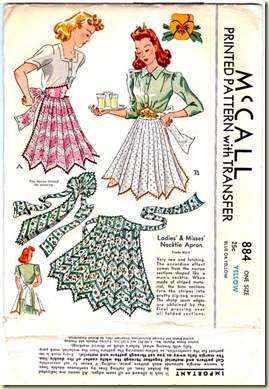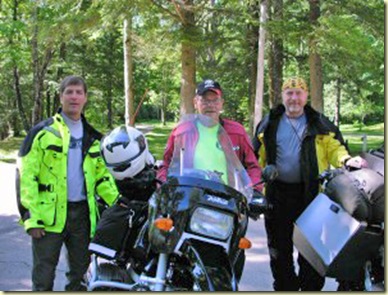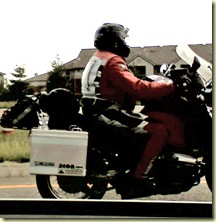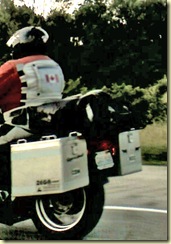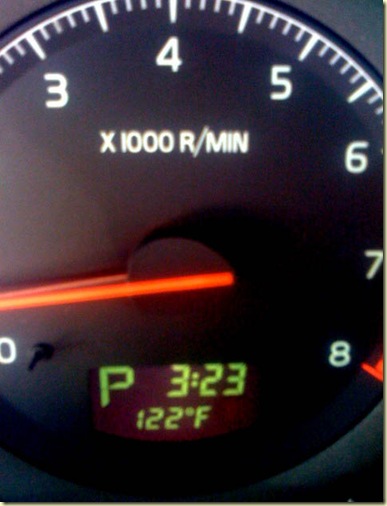
The second weekend in June has come and gone and with it the 32nd annual Iowa Rally, put on by the Pure Stodge Touring Association, a long-standing BMW motorcycle club.
Despite flooding in the state, the rally went on this year at the Iowa County Fairgrounds in Marengo, Iowa. We didn't make it to this year's rally.
In fact, I haven't been to an Iowa Rally since 2000.
Back then, the rally was held at a campground owned by Keith Dempster near Coralville, Iowa.
Dempster knews how to put on a good party. After 39 years in the restaurant business, a decade at the helm of the BMW Motorcycle Owners of America, and a lot of years organizing national and local motorcycle rallies, Dempster had the knowledge and experience that made his Iowa Rally one of the best in the country.
The four-day event is an all-brands affair. You’ll see plenty of Harleys and Hondas, as well as a liberal mix of Moto Guzzis and Ducatis too.
Keith and Pam Dempster hosted the rally on their 32-acre farm and campground near Coralville, an upscale western suburb of Iowa City on Interstate 80. The 2000 Iowa Rally was dogged by cloudy skies and showers, but still drew about 800 people. The record over the 24-year history of the event is about 1,200.
The key, commented Keith, is the weather for a 500-mile radius around Iowa City. “It’s not so much how the weather is here, but how it is in Colorado Springs or Kansas City or Chicago or Detroit,” he said. “Even for some of the committed lifestyle riders, it’s hard to pull out of your barn or garage into a monsoon when you’re doing this for the fun of it and you don’t really have to be here.”
Folks looking for the Total Iowa Rally Experience begin showing up on Thursday and are rewarded with a free pre-rally hog roast that evening. Besides three nights’ camping, the rally fee also includes a chili supper Friday night and a Saturday night steak dinner with all the trimmings.
At registration, you’re fitted with a wristband, get a strip of door prize drawing tickets, and a 16-ounce plastic cup emblazoned with the Pure Stodge Touring Association logo. You can fill the cup with free soft drinks, coffee, or beer from strategically placed spigots on the rally grounds anytime, night or day, for the duration of the rally.
The gravel road to the camping areas wound past a vendor midway and mechanic’s station, the shelter house where meals were served, the shower/restroom building, and down the hill past the bandstand. Bands were booked for dancing Friday and Saturday nights. And a Saturday night awards ceremony recognizes the oldest and youngest riders, longest distances traveled, and other achievements.
Some folks preferred camping in the woods close to the food, showers, and other amenities, while others gravitated farther down the slope to a flat, grassy expanse near the site of the Saturday afternoon field events. For those who wanted to rally but didn’t care to camp, there are over 2,000 motel rooms within five miles of the site.
The 2000 event was the 25th annual Iowa Rally and the eighth I’ve attended since 1992. I kept coming back because of the amenities and the variety of experience. You could hang around the rally grounds looking at bikes, cruise the vendors, and meet old and new friends. If you were up for a ride, there were plenty of interesting places to go.
A short ride to the west takes you to the Amana Colonies. Also close at hand are the Grant Wood/Stone City Arts Festival, the Herbert Hoover Library, and a fascinating fossil bed that was exposed in the wake of 1993 flooding. If you’re up for a Saturday morning ride, you could head to the Brooklyn Festival of the Flags about 50 miles west on U.S. 6, where the whole county turns out for a flag-waving parade down the main street.
Here's a story I wrote for
Motorcycle Tour & Cruiser magazine that ran in the May, 2001, issue:

By John M. Flora
With the rising sun at our backs and an Iowa blacktop curving away before us, the world looked shiny and new on this fine June morning.
Yesterday’s five-hour interstate slog from Indianapolis to Coralville, Iowa, now seemed like a minor inconvenience as Maria and I faced the prospect of a warm, cloudless day - all ours to spend exploring. We’d come for the Iowa Rally, one of the best BMW club-sponsored rallies in the country, but we also wanted to experience the charm of the Amana Colonies.
This cluster of seven villages was founded 150 years ago in the Iowa River Valley by the “Community of True Inspiration,” a German Protestant sect that came to the United States in search of religious freedom. Under their communal system of living, all land and buildings were owned by the group. Families were assigned living quarters and each person over school age had a job in the fields, factories, shops, or kitchens. The Amana Church Society was created to handle religious matters, and the Amana Society Inc. oversaw the farming and business operations. The system lasted until the residents voted to abolish it in 1932.
Turning north at the intersection of U.S. 6 and U.S. 151, we descended into the Iowa River Valley. A light mist hung over the river. I caught a glimpse of an egret stepping gracefully into the air as we swept over the bridge and closed the distance to Amana, the largest of the villages. Flipping up my visor to drink in the cool morning breeze, I thumbed my right turn signal and gave the throttle a little twist to negotiate the uphill right turn onto 220th Trail, Amana’s main street.
It was only 7 a.m. and we had the street to ourselves. My ’91 BMW K100RS hummed past stolid-looking brick and stone shops and businesses with such German-sounding names as the Chocolate Haus, Der Weinkeller, and Ronneburg Restaurant. I angled right again on 47th Avenue at the east end of town and pulled into a parking space in front of the Colony Inn.
The Colony Inn’s family-style breakfast is one of my all-time favorite food discoveries, and they can count on my business anytime I’m in the neighborhood. Waitresses in navy blue dresses with starched white aprons and matching collars and cuffs bustle across the creaking wood floor from the kitchen, arms laden with pancakes, eggs, nutmeg-seasoned Amana-made sausage, bacon, and fried potatoes. There’s also orange juice, fruit, and toasted English muffins with the Colony Inn’s own homemade jam. The determined waitresses make the blue-and-white checked tablecloths disappear beneath serving after serving - offered continuously until you beg them to stop.
Thus fortified, we settled our bill and saddled up to explore the Amana Colonies. Riding through Amana (sometimes called Main Amana because it’s bigger than the other villages), we noticed how well-kept the homes are. Surrounded by neatly manicured lawns, many of the wood frame houses have trellises tacked to their west, south, and east sides, frameworks for grapevines to climb in the summer sun.
Riding west on 220th Trail over the undulating countryside, we soon spied the Amana appliances plant on the east edge of Middle Amana. If the name Amana was part of your vocabulary before you began this story, chances are it’s because of the Amana line of appliances.
The Amana Corp. was founded here in 1934 when young entrepreneur George Foerstner hired local craftsmen and cabinetmakers to build beverage coolers. The Amana business grew over the years to include refrigerators and room air conditioners, but really took off in 1967 with the introduction of the Radarange, the first countertop microwave oven built for home use. Today, the Amana name also can be found on dishwashers, freezers, wall ovens, ranges, cooktops, dehumidifiers, and washers and dryers.
Besides the Amana Corporation’s headquarters, Middle Amana has three bed and breakfasts and a bakery. At the Communal Kitchen and Coopershop Museum, you can see how meals for the entire community were prepared by designated kitchen workers and also inspect the workshop and tools used for repairing wagons.
We continued west another couple of miles to High Amana, so named because it stands on the crest of a hill, higher than the other villages. We parked and pulled off our helmets to explore the shady High Amana cemetery with its view of the surrounding countryside.
Returning to the bike, we were beset by a small terrier who bolted from his yard across the street to yap and growl at these two leather-clad intruders. A moment later, his master, Ivan Hartley, strolled over to intercede. Hartley, it turned out, was the first outsider to build a house in High Amana.
Explaining local cemetery protocol, Hartley told us his final resting place will be in a pine box in the corner section set aside for those who aren’t members of the Community of True Inspiration. Noting that church members are buried in chronological order, rather than in family groups, he swept back an unruly shock of brown hair and laughed, “So you could be buried next to your worst enemy!”
Hartley invited us over to his garage to see the birdhouses he builds from scrap lumber, then surprised us with a tour of his basement where he keeps an amazing collection of toy truck banks. He has hundreds in wood cases and has been featured in a bank collector’s magazine. We felt we’d discovered a new friend and a treasure.
Another mile down the road lies West Amana. Here, we paused long enough to inspect the antique and basket shops and the cool dark general store with its high, old-fashioned decorative tin ceiling.
Turning south, we crossed the millrace that dates from the 1860s and then the Iowa River. We cruised through South Amana, with its furniture shops, two bed and breakfasts, and museums. From South Amana, we picked up U.S. 6 and rode east, making quick work of the five miles to Homestead. We found the western approaches to this colony awash with orange. It was the annual Homestead Implement Reunion weekend, and we’d stumbled across the rallying point for the Allis-Chalmers collectors.
The Milwaukee-based Allis-Chalmers firm built tractors and other farm implements from 1914 to 1985 and scores of their lovingly restored machines - painted the distinctive “Allis-Chalmers orange” - filled the field around a huge orange-and-white striped tent. Under the canopy, we checked out the displays, examined a replica Allis-Chalmers tractor made from wooden matchsticks, and enjoyed dishes of blended orange sherbet and vanilla ice cream.
We recognized in these Allis-Chalmers collectors the same common thread of brand loyalty and dedication that unites BMW riders, Harley folks, and Gold Wing people. Almost all had farm backgrounds that included warm and fuzzy memories of the huff and chuff of an Allis-Chalmers tractor churning through an open field.
The A-C folks mentioned there was a similar contingent of Minneapolis Moline collectors on the other side of town and persuaded us to stick around for a parade of the two groups’ combined rolling stock. We found comfortable seats under a shady tulip tree and took in the sights and sounds as a mile-long cavalcade of orange Allis-Chalmers and yellow Minneapolis Molines chugged past. Their drivers smiled and waved to the small but appreciative crowd. Here and there, a young boy or girl sat on daddy’s lap behind the big tractor steering wheel, grinning with delight.
Congratulating ourselves on our morning’s discoveries, Maria and I pulled on jackets and helmets and rode the three miles back to Amana, closing our loop of the colonies and looking for a light lunch. We found it at a local wine and cheese shop. We dined on the porch, sharing a chunk of Gouda and some summer sausage, and washing it down with soft drinks. Our tour of the colonies concluded with a visit to Heritage Designs Needlework and Quilting, where we picked out fabric swatches for a quilt Maria is making to commemorate our motorcycle travels.
Back at the Iowa Rally that night, I drifted off to sleep thinking about the kindred spirits we’d found in Ivan Hartley and the tractor folks. Life is good, I decided, when you can spend a pleasant weekend immersed in whatever makes you happy, whether it be motorcycles, toy banks, or big, orange tractors.
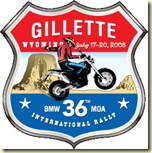 right after the July 17-20 BMW Motorcycle Owners of America International Rally in Gillette, Wyo. (See logo.)
right after the July 17-20 BMW Motorcycle Owners of America International Rally in Gillette, Wyo. (See logo.)
